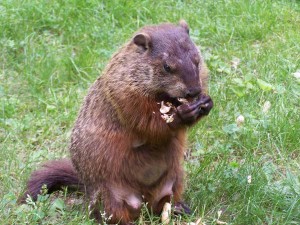Groundhog Day: An American Pagan Holiday
February 2nd is the pagan holiday known as variously as Imbolc, Brigid’s Day, Candlemas and many other names. Many calendars label it “Groundhog’s Day,” referring to the adage that the length of the remaining winter is determined by whether the groundhog sees his shadow (i.e., whether the sun is shining) on this day.Groundhog Day is an American adaptation of vestigial bear worship, brought to the Pennsylvania colony by early German settlers. Bear worship in central Europe goes back to the Neanderthals, who left Cave Bear skulls in an excavated cavern in Switzerland. Statuettes from the region dedicated to bear goddesses date to the days of the Roman occupation. In Christian times the belief persisted that on Candlemas the bear would waken from her slumber for a winter perambulation. Candlemas is a Christian holiday (the purification of the Virgin Mary) with pagan antecedents across Western Europe. It is the time when the days lengthen noticeably, and people naturally begin to wonder when spring will arrive. If the bear sees her shadow, tradition says, spring will come in another six weeks. Conveniently, this coincides with the vernal equinox, another pagan holiday.In places where the bear has long been absent, other hibernating animals have been appointed weather-watchers on Candlemas. The hedgehog is a favorite, and the badger is sometimes mentioned. But the hedgehog is absent in North America, and the badger has long retreated to the upper Midwest. In the open farm country of Pennsylvania, the bear also retreated to far off wooded regions, so the groundhog, which proliferates in cleared woodland, became the designated officiant of the winter holiday.The groundhog is a member of a family called the marmots, found in some form throughout the Northern Hemisphere. The groundhog is a marmot unique to North America. Like the bear, she often stands on two legs, and she hibernates in the winter. Unlike the bear, she is a true hibernator, not stirring at all during the winter by her own inclination. Hence the town mascots, the most famous of which is Punxsutawney Phil, who are prodded awake on the fateful day.Groundhog Day exemplifies a Euro-pagan tradition adapted successfully to North American soil.

